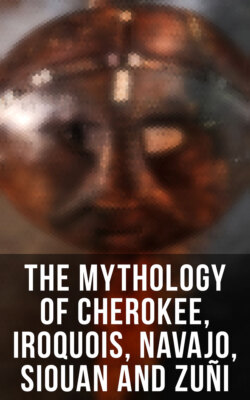Читать книгу The Mythology of Cherokee, Iroquois, Navajo, Siouan and Zuñi - James Mooney - Страница 171
На сайте Литреса книга снята с продажи.
The Herds of Buffalo-Stealer
ОглавлениеIn the morning they were once more dog and stick. When the woman and her child awoke they set off for the woods again, the former taking the stick to dig for roots, the latter calling for his little dog to accompany him. Alas! when they reached the spot they had fixed upon for root-gathering operations both dog and stick had vanished! And this was the reason for their disappearance. As the dog was trotting through the wood he had observed an opening like the mouth of a cavern, all but concealed by the thick undergrowth, and in the aperture he perceived a buffalo. His short, sharp barking attracted the attention of the stick, which promptly wriggled snake-wise after him. Within the cavern were great herds of deer and buffalo, enough to provide the Blackfeet with food for years and years. Nápi ran among them, barking, and they were driven out to the prairie.
When Buffalo-stealer returned and discovered his loss his wrath knew no bounds. He questioned his wife and son, but they denied all knowledge of the affair.
"Then," said he, "it is that wretched little dog of yours. Where is he now?"
But the child could not tell him.
"We lost him in the woods," said he.
"I shall kill him," shouted the man, "and I shall break the stick as well!"
Nápi overheard the threat, and clung to the long hair of an old buffalo; He advised the stick to conceal itself in the buffalo's hair also, and so the twain escaped unnoticed from the cave, much as did Ulysses from the Cyclops' cavern. Once again they took the form of men, and drove a herd of buffalo to the Blackfoot camp, while Buffalo-stealer and his family sought them in vain.
The people met them with delighted acclamations, and the famine was at an end. Yet there were still some difficulties in the way, for when they tried to get the herd into the enclosure a large grey bird so frightened the animals with its dismal note that they refused to enter. This occurred so often that Nápi suspected that the grey bird was no other than Buffalo-stealer. Changing himself into an otter, he lay by the side of a river and pretended to be dead. The greedy bird saw what he thought to be a dead otter, and pounced upon it, whereupon Nápi seized him by the leg and bore him off to the camp. By way of punishment he was tied over the smoke-hole of the wigwam, where his grey feathers soon became black and his life a burden to him.
"Spare me!" he cried. "Let me return to my wife and child. They will surely starve."
His piteous appeals moved the heart of Nápi, and he let him go, but not without an admonition.
"Go," said he, "and hunt for food, that you may support your wife and child. But do not take more than you need, or you shall die."
The bird did as he was bidden. But to this day the feathers of the raven are black, and not grey.
